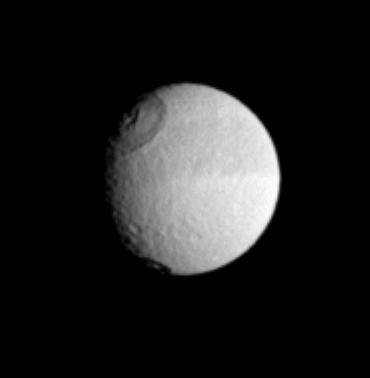With the Band

| PIA Number | PIA07571 |
|---|---|
| Language |
|
Saturn's moon Tethys displays its distinctive dark equatorial band here, along with two sizeable impact craters in the west. The larger crater to the north is Odysseus, which has a diameter (450 kilometers or 280 miles across) that is a substantial fraction of the moon's width. Tethys is 1,071 kilometers (665 miles) across.
Several moons in the outer solar system have large impact features like Odysseus, and scientists are interested in learning how such powerful impacts have altered the moons' surfaces.
The image was taken in visible light with the Cassini spacecraft narrow-angle camera on July 10, 2005, at a distance of approximately 1.8 million kilometers (1.1 million miles) from Tethys. The image scale is 11 kilometers (7 miles) per pixel. The image has been magnified by a factor of two to aid visibility.
The Cassini-Huygens mission is a cooperative project of NASA, the European Space Agency and the Italian Space Agency. The Jet Propulsion Laboratory, a division of the California Institute of Technology in Pasadena, manages the mission for NASA's Science Mission Directorate, Washington, D.C. The Cassini orbiter and its two onboard cameras were designed, developed and assembled at JPL. The imaging operations center is based at the Space Science Institute in Boulder, Colo.
For more information about the Cassini-Huygens mission visit http://saturn.jpl.nasa.gov . The Cassini imaging team homepage is at http://ciclops.org .
Credit: NASA/JPL/Space Science Institute
